Homemade green enchilada sauce is the secret to making enchiladas verdes taste fresh, tangy, and authentic. Instead of relying on canned sauces, you can prepare this easy recipe from scratch with tomatillos, green chiles, garlic, and cilantro. The result is a vibrant sauce that works not only for enchiladas but also for casseroles, grain bowls, and even breakfast dishes.
Why Make Green Enchilada Sauce at Home?
Store-bought sauces are convenient, but they often include preservatives and unnecessary sodium. When you prepare it yourself, you control the heat level, the freshness of the vegetables, and even the thickness of the sauce. Homemade green enchilada sauce can be mild for family meals or spicy if you prefer bold flavors. It also adapts easily to dietary needs like gluten-free or dairy-free.
For example, pairing this sauce with dishes like a street corn chicken rice bowl adds depth and authentic flavor. You can also drizzle it over baked meats such as smoked chicken breast for a quick dinner upgrade.
Culinary experts also highlight that homemade sauces bring out natural flavors that pre-made jars simply cannot match. According to Serious Eats, roasting vegetables before blending enhances sweetness and adds a smoky note, which is perfect for this recipe. Similarly, Mexico In My Kitchen points out the cultural importance of tomatillos and chiles in Mexican cooking, reinforcing the authenticity of making your own.
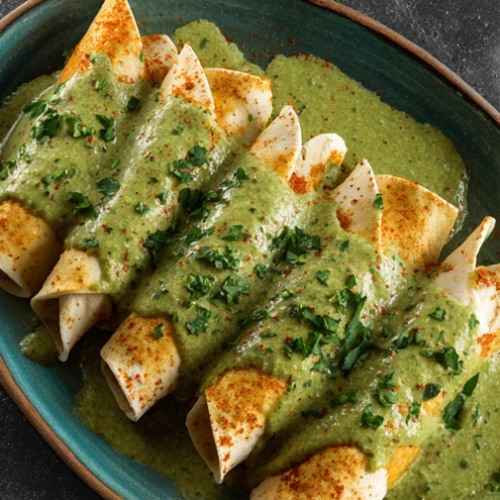
Homemade Green Enchilada Sauce: Ingredients and Key Swaps
The foundation of a great homemade green enchilada sauce starts with fresh vegetables, fragrant herbs, and a touch of spice. The beauty of this recipe is that you can adapt it to what you have on hand, whether it’s tomatillos, green tomatoes, or mild chiles.
Core Ingredients
- Tomatillos: These provide the tangy base. If you’ve tried making Mexican-inspired dishes such as this Mexican hot sauce recipe, you’ll recognize their bright flavor.
- Onion and garlic: For savory depth.
- Cilantro and lime juice: To keep the sauce fresh and aromatic.
- Broth (chicken or vegetable): Adds body and richness.
Chile Choices
Different peppers bring different levels of heat and flavor:
- Anaheim or Hatch chiles: Mild with a slightly sweet finish.
- Poblano peppers: Earthy and rich, perfect for a mild homemade green enchilada sauce.
- Jalapeño or serrano: Add heat and sharper spice.
For a creamy twist, you can blend in sour cream after cooking. This variation is often searched as homemade creamy green enchilada sauce with sour cream.
Optional Add-ins
- Green tomatoes: Useful when tomatillos aren’t available, leading to a subtle difference in taste but still authentic.
- Canned green chilies: A quick swap if you need a semi homemade version.
- Spices: Mexican oregano or cumin can boost flavor depth.
If you are experimenting with sauces at home, compare this to the roasted red pepper sauce for a different but equally versatile option.
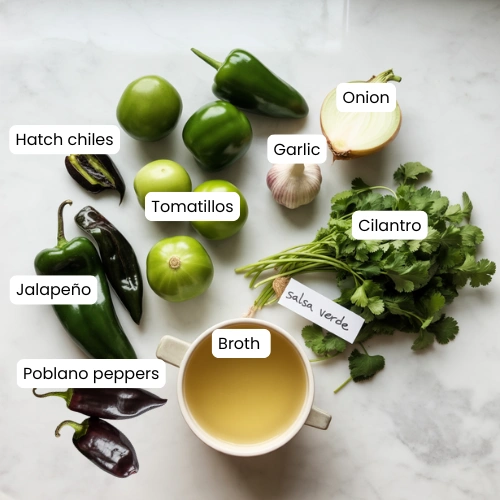
How to Make Homemade Green Enchilada Sauce (Quick Method)
Making your own sauce takes less than 30 minutes and requires only a few simple steps. Whether you prefer roasted vegetables for a smoky depth or a quick boil for speed, the method is straightforward.
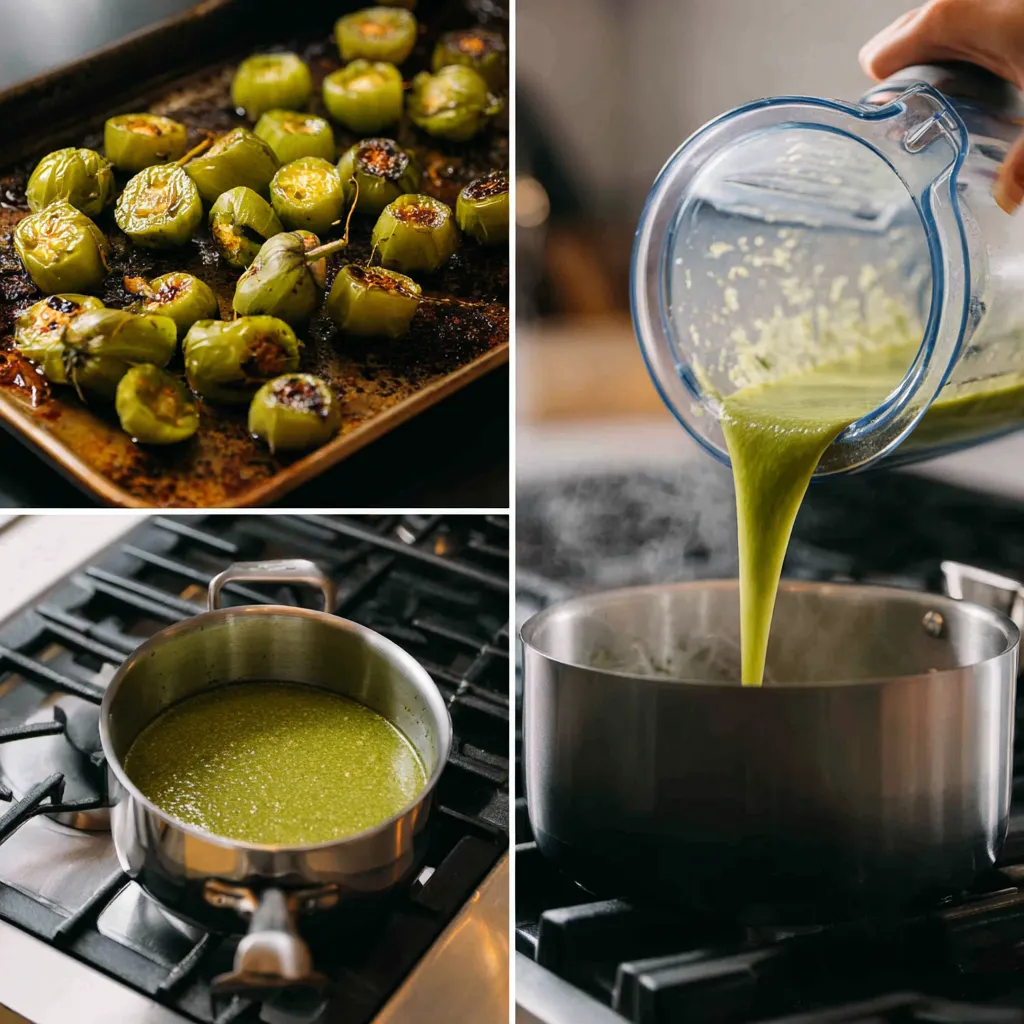
Roast or Boil the Vegetables
Roasting tomatillos, chiles, and garlic intensifies their flavor. Place them on a baking sheet and roast until slightly charred. If you are short on time, boiling works too, though the sauce will be a bit lighter in flavor. According to The Kitchn, roasting adds complexity that makes the sauce taste closer to authentic Mexican versions.
Blend Until Smooth
Transfer the cooked vegetables into a blender with onion, cilantro, broth, and lime juice. Blend until you achieve a smooth consistency. If you enjoy sauces with body, keep it slightly chunky.
Tip: Avoid over-blending with sour cream if making a creamy variation, as it can dull the bright green color.
Simmer and Season
Pour the blended sauce into a saucepan. Simmer for 10 minutes to thicken and allow flavors to combine. Adjust the seasoning with salt, pepper, and a pinch of sugar if the tomatillos are too tangy.
For comparison, sauces like this pair well with hearty dishes such as ground beef stroganoff, where a vibrant, tangy sauce balances the richness of meat.
Best Homemade Green Enchilada Sauce from Scratch: Pro Tips
Even though the recipe is simple, a few professional tricks will take your sauce from good to unforgettable. These adjustments help you balance flavors, customize the heat level, and improve texture.
- Pick the right chiles: Anaheim or Hatch chiles give a mild, slightly sweet flavor. For more heat, add jalapeños or serranos. If you want a smoky base, roast poblano peppers first.
- Balance the tang of tomatillos: Some tomatillos are more acidic. A pinch of sugar or an extra splash of broth softens their sharpness.
- Adjust thickness naturally: Simmering longer creates a thicker sauce. If you’re in a hurry, stir in a cornstarch slurry.
- Go creamy when needed: Stir in sour cream at the end for a version often called homemade creamy green enchilada sauce. This is ideal for chicken casseroles or enchiladas with sour cream white sauce.
- Keep it gluten-free: Use cornstarch or arrowroot instead of flour. This aligns with the growing interest in gluten free dairy free breakfast recipes and ensures the sauce fits multiple diets.
Adding cultural context makes the sauce even more special. Mexican cooking often layers flavor by roasting vegetables and simmering sauces slowly. Using regional chiles such as Hatch peppers brings you closer to authentic enchiladas verdes served in traditional kitchens.
Troubleshooting and Texture Fixes
Even the best cooks sometimes end up with a sauce that isn’t quite right. Fortunately, small adjustments can fix common problems with homemade green enchilada sauce.
Too Thin
If the sauce feels watery, simmer it longer to allow excess liquid to evaporate. For a quick fix, stir in a cornstarch slurry. This technique also works well in other dishes, such as thickening a creamy parmesan Italian sausage soup.
Too Tangy
Tomatillos can sometimes overpower the balance with their acidity. To soften the sharpness, add a pinch of sugar, a splash of extra broth, or a little sour cream if you are making a creamy version.
Too Pale or Muddy in Color
Over-blending with dairy or overcooking can dull the sauce’s bright green shade. To restore vibrancy, add a handful of fresh cilantro or roast your peppers before blending.
Too Spicy
If the sauce is hotter than you expected, add more tomatillos or broth to dilute the heat. You can also combine it with a milder batch to balance the flavors.
By understanding how to fix these issues, you save your sauce and avoid waste. As Serious Eats notes, the secret to a memorable sauce lies in balancing flavors and textures at every step.
Variations People Search For
Homemade green enchilada sauce is versatile, and there are many ways to adjust it depending on the ingredients you have or the flavors you enjoy. These variations are among the most searched and help your recipe stand out.
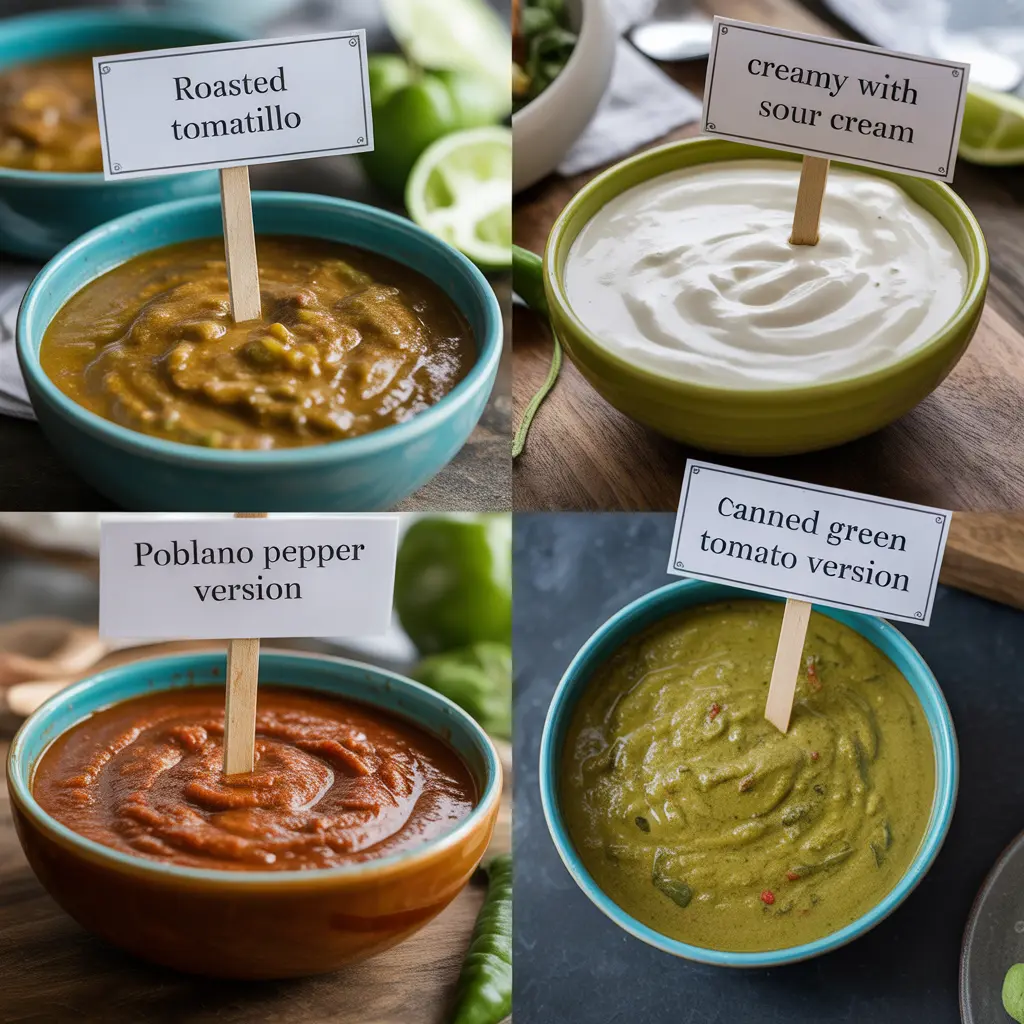
Homemade Green Enchilada Sauce with Roasted Tomatillos
Roasting tomatillos intensifies their natural sweetness and reduces acidity. This creates a deeper, more authentic flavor profile. It’s ideal for classic enchiladas verdes or as a topping for roasted meats like smoked chicken breast.
Homemade Creamy Green Enchilada Sauce (with Sour Cream)
Adding sour cream at the end produces a silky, mild version. This works perfectly for chicken enchiladas with sour cream white sauce and casseroles that benefit from richness.
Semi Homemade Green Enchilada Sauce
For busy nights, blend canned green chilies with onion, garlic, broth, and a pinch of cumin. While not as vibrant as a fully fresh sauce, this shortcut still beats most store-bought versions.
Homemade Green Enchilada Sauce with Poblano Peppers
Poblanos provide a smoky, earthy tone with gentle heat. This variation works especially well in Tex-Mex style dishes like a taco salad bowl.
Homemade Green Enchilada Sauce with Green Tomatoes
If tomatillos aren’t in season, green tomatoes are a solid replacement. They deliver tanginess, though the flavor will be slightly less citrusy. Pair with pork or beef casseroles for balance.
Homemade Authentic Mexican Green Enchilada Sauce
For a traditional taste, combine roasted Hatch or Anaheim chiles, fresh cilantro, garlic, and Mexican oregano. As explained on Mexico In My Kitchen, these ingredients mirror what is used in authentic Mexican households.
Homemade Green Enchilada Sauce for Canning
This sauce adapts well for long-term storage. Prepare in large batches and preserve using safe water bath or pressure canning methods. Always follow tested canning guidelines from trusted sources like the National Center for Home Food Preservation.
Storage, Freezing, and Canning
One of the biggest advantages of making homemade green enchilada sauce is how well it stores. With the right steps, you can prepare a large batch and enjoy it for weeks or even months.
Fridge Storage
Keep the sauce in an airtight container for up to 5 days. The flavors deepen as it sits, making it even better for quick weeknight meals. Try it drizzled over a street corn chicken rice bowl for a fast dinner.
Freezing Homemade Green Enchilada Sauce
Yes, you can freeze homemade green enchilada sauce. Portion it into freezer bags or containers, ideally in 1–2 cup sizes. Lay flat for easy stacking and label with the date. It will last up to 3 months. After thawing, stir well to restore consistency.
Homemade Green Enchilada Sauce for Canning
If you want shelf-stable sauce, canning is a great solution. Prepare the sauce as usual, then follow safe water bath or pressure canning methods. The National Center for Home Food Preservation provides tested guidelines that ensure safety and quality.
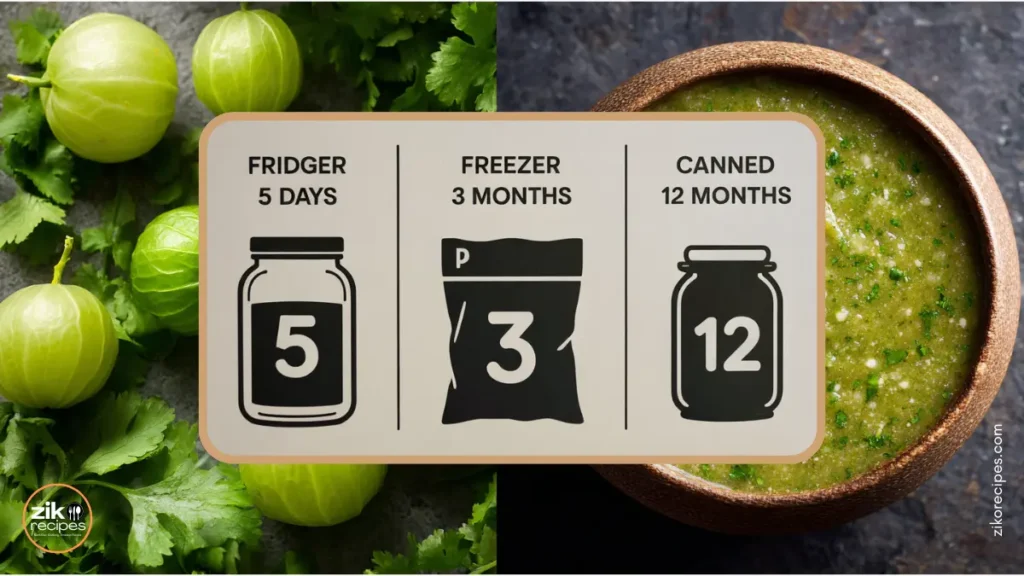
Storage Table
| Storage Method | Duration | Notes |
|---|---|---|
| Fridge | Up to 5 days | Store in airtight container |
| Freezer | 3 months | Portion into 1–2 cup bags or containers |
| Canning | 12–18 months | Follow approved canning guidelines |
This clear breakdown helps readers choose the best method for their cooking routine. And If you plan to can your homemade green enchilada sauce, it’s important to follow safe preservation practices. The National Center for Home Food Preservation provides clear, research-based guidelines that ensure your sauce stays safe for long-term storage.
Serving Ideas: What to Put It On
Homemade green enchilada sauce isn’t limited to enchiladas. Its tangy, slightly smoky flavor makes it one of the most versatile sauces in your kitchen. Here are some creative ways to use it.
- Classic chicken enchiladas: Pour the sauce over rolled tortillas filled with chicken, cheese, and onions, then bake until bubbling. Pairing it with creamy sides like garlic parmesan chicken pasta creates a complete comfort meal.
- Enchiladas verdes de pollo: Authentic chicken enchiladas with roasted tomatillo sauce, a staple of Mexican cuisine.
- Breakfast boost: Drizzle over scrambled eggs, chilaquiles, or even breakfast burritos.
- Tex-Mex casseroles: Use as a layering sauce in baked dishes, similar to a cowboy meatloaf and potato casserole but with a Mexican twist.
- Soup enhancer: Stir a spoonful into chicken or vegetable soups for instant depth.
- Grain bowls and salads: Mix a few tablespoons into bowls like the roasted veggie grain bowl for a tangy kick.
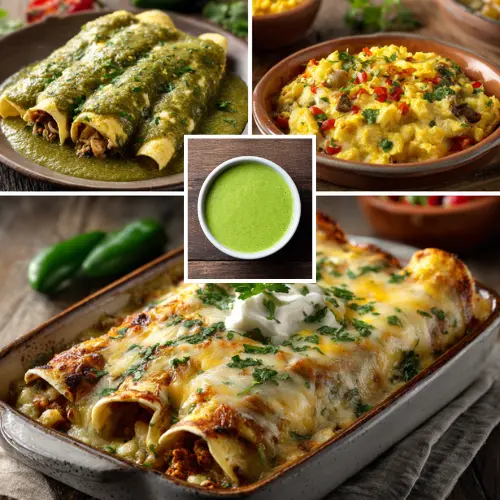
Green enchilada sauce also makes a great dipping sauce for tortilla chips or roasted vegetables.
Green vs Red, and Salsa Verde vs Green Enchilada Sauce
When people search for enchilada sauces, they often wonder about the differences between green and red versions or whether salsa verde can replace enchilada sauce. Here’s a clear breakdown.
Green Enchilada Sauce vs Salsa Verde
Green enchilada sauce and salsa verde share many ingredients, like tomatillos, green chiles, garlic, and cilantro. The key difference is that enchilada sauce is simmered with broth, which gives it a smoother texture and deeper body. Salsa verde is usually raw or quickly blended, making it brighter and tangier. While salsa verde can work as a substitute, simmering it with broth and seasoning transforms it into a closer match to green enchilada sauce.
Green vs Red Enchilada Sauce
Green enchilada sauce is typically made with tomatillos and green chiles, giving it a tangy and fresh flavor. By contrast, red enchilada sauce relies on dried red chilies, tomatoes, and smoky spices for a deeper taste. The green version feels lighter and brighter, while the red is often richer, bolder, and more earthy. Both are authentic, and the choice often comes down to the dish. For example, green pairs beautifully with chicken or pork, while red often complements beef or cheese enchiladas. If you enjoy experimenting with sauces, try the 3 ingredient BBQ sauce for a completely different flavor direction.
Green Enchilada Sauce Substitutes
If you run out of green enchilada sauce, the easiest substitute is salsa verde simmered with broth and spices. You can also use roasted green chile salsa or even blend roasted poblano peppers with garlic and lime for a quick homemade fix.
Frequently Asked Questions (FAQ)
Green enchilada sauce is typically made from tomatillos, green chiles, onion, garlic, cilantro, broth, and lime juice. Roasting the vegetables before blending gives the sauce a deeper, more authentic flavor.
Not exactly. While they share many ingredients, salsa verde is usually blended raw or lightly cooked. Green enchilada sauce, on the other hand, is simmered with broth, which makes it smoother, richer, and better for baking dishes like enchiladas.
A quick substitute is salsa verde simmered with broth and spices. You can also blend roasted green tomatoes or poblano peppers with garlic and lime for a homemade alternative. Store-bought options like Mexican hot sauce can also work in a pinch, though the flavor will differ.
It depends on the peppers you choose. Anaheim and poblano chiles are mild, while jalapeños and serranos bring more heat. You can adjust the spice level by mixing different peppers or removing seeds and membranes for a milder sauce.
Yes, homemade green enchilada sauce freezes very well. Portion it into 1–2 cup containers or bags, then freeze for up to 3 months. Stir after thawing to restore consistency. For longer storage, consider canning using safe preservation methods.
When preserving sauces, safety matters as much as flavor. The CDC on home-canned foods warns that improper canning can lead to botulism. Always use tested methods and store jars properly.

Homemade Green Enchilada Sauce
Equipment
- Oven
- Baking tray
- Blender
- saucepan
- Knife and cutting board
Ingredients
- 500 g fresh tomatillos (or green tomatoes)
- 2 poblano peppers, halved and deseeded
- 1 jalapeño or serrano pepper (optional, for heat)
- 4 cloves garlic, unpeeled
- 1 medium onion, quartered
- 500 ml chicken or vegetable broth
- 1 bunch fresh cilantro
- 2 tbsp lime juice (freshly squeezed)
- 1 tsp salt, or to taste
- 1 tsp sugar (optional, to balance acidity)
- 1 tbsp oil, for roasting
Instructions
- Preheat oven to 200°C (400°F). Place tomatillos, poblano peppers, jalapeño, onion, and garlic on a baking tray. Drizzle with oil and roast for 15 minutes until slightly charred.
- Remove garlic skins and transfer all roasted vegetables to a blender. Add cilantro, broth, lime juice, salt, and sugar. Blend until smooth or slightly chunky, depending on desired texture.
- Pour the blended sauce into a saucepan. Simmer over medium heat for 10–15 minutes to thicken and combine flavors. Stir occasionally.
- Taste and adjust seasoning. Add more salt, lime, or sugar if needed. For a creamy version, stir in sour cream at the end off-heat.
- Use immediately, or cool and store in the fridge up to 5 days, or freeze for up to 3 months.
Notes
Reader Tips and Customizations
Every cook has their own style, and green enchilada sauce is one of those recipes that welcomes creativity. Readers often adjust ingredients based on heat preference, availability, or dietary needs.
- Heat control: Some prefer a fiery batch with extra serranos, while others make a mild sauce using only poblanos or Anaheim peppers.
- Flavor balance: A splash of lime brightens the sauce, while a pinch of sugar softens tanginess from tomatillos.
- Dietary swaps: Use vegetable broth for a vegetarian version, or add sour cream for a creamy finish.
We’d love to hear how you made this recipe your own. Did you try it with roasted tomatillos? Did you make a freezer-friendly batch? Share your tips in the comments so other readers can learn from your version.
If you enjoy experimenting with sauces, you might also like pairing this with the tahini sauce for fusion-style meals, or using it alongside classics like roasted red pepper sauce for variety in your kitchen.




